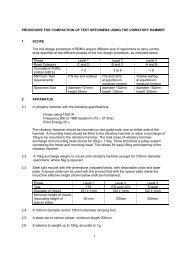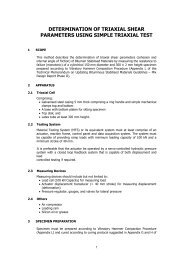Updating Bituminous Stabilized Materials Guidelines Mix Design Report Phase II
Moisture Sensitivity: Part II (Validation) - Asphalt Academy
Moisture Sensitivity: Part II (Validation) - Asphalt Academy
- No tags were found...
You also want an ePaper? Increase the reach of your titles
YUMPU automatically turns print PDFs into web optimized ePapers that Google loves.
- No sign of significant initial densification occurred on BSMs. However, cohesion loss or<br />
stiffness reduction of the trafficked materials increases as number of load application<br />
increases.<br />
- The level of disintegration and ravelling on BSMs under wet trafficking, shows that<br />
cohesion loss and stiffness reduction develop progressively. The failure mechanism of<br />
BSMs is that severe reduction of cohesion or stiffness occurs, before exponential loss of<br />
materials occurred.<br />
- Sample preparation need care to ensure smoothness of the test surface. Briquettes that<br />
spalled during cutting show an early disintegration on wet trafficking.<br />
- The performance of BMSs exposed to moisture during trafficking shows significant<br />
differences. The long cured BSM-emulsion proves to be moisture resistant, than BSMs<br />
with laboratory accelerated curing.<br />
- The influence of the addition of the active filler in BSMs is vital for the improvement in<br />
moisture susceptibility. The results indicate that BSMs with addition of 1% cement is<br />
more moisture resistant compared to BSMs with addition of Lime or no active filler.<br />
However interesting results on the addition of 1% lime is that, the BSMs endure moisture<br />
resistant to a certain saturation level up to 80%, thereafter exponential disintegration<br />
occurred.<br />
4.3 Testing Temperature<br />
- The MMLS3 wet trafficking and ITS tests were conducted at controlled 25 o C. It is obvious<br />
that the field temperature on BSMs varies significantly, however in South Africa moisture<br />
related damage occurred during rainfall period. During that period air temperature, do<br />
not exceed 30 o C. Therefore, BSM-layer being a base or subbase its temperature will not<br />
excess 25 0 C.<br />
4.4 ITS test results<br />
- The comparison of the ITS Values in all BSMs show no significant difference, with<br />
exception of BSM-emulsion made of quartzites and no active filler. This indicates that ITS<br />
test is not particular sensitive to moisture effect.<br />
- From the analysis, long term cured BSM-<strong>Mix</strong>es proved to be highly moisture resistant<br />
compared to laboratory accelerated cured BSM-mixes. However the ITS results show<br />
insignificant difference between these BSMs. The lack of reliability and repeatability of<br />
the ITS test for use in ranking BSMs in terms of moisture susceptibility, should preclude<br />
its use for important applications of BSMs.<br />
- Ravelling-depth of 4mm under the MMLS3 wet trafficking appears to be critical. It is<br />
appropriate to extend testing beyond 4mm for better screening the BSMs.<br />
33












